#software developer manual
Explore tagged Tumblr posts
Text
Automated Testing vs. Manual Testing: Which One is Right for Your Project?

Achieving high-quality, reliable software stands as a fundamental requirement in software development. Successful testing functions as an essential tool to discover faults and build performance capabilities that create better user experience outcomes. Two main testing methods dominate the field: automated testing and manual testing. The process of quality software assurance uses different testing approaches that demonstrate their own advantages as well as weaknesses according to specific project requirements and scenarios. We will explore the specifics to determine which testing process works best for your system development efforts.
1. What Is Manual Testing?
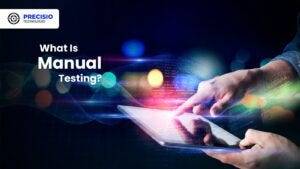
Manual testing involves a human tester manually executing test cases without using automation tools. Key Characteristics:
The methodology focuses its efforts on user interface together with usability and experience testing.
Human-centered applications where selection requires discretion include ad hoc testing and enumerative testing as well as examinations that need human evaluation.
Human performers are required during this approach; thus, it demands substantial time.
2. What Is Automated Testing?
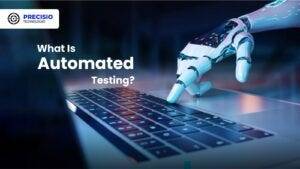
Software performing automated testing executes test cases through workflows and helpers. Key Characteristics:
Efficient for repetitive and regression testing.
Users must spend money on tools along with developing custom scripts for testing.
Reduces human error.
3. Advantages of Manual Testing

Human Intuition: Software testing professionals can detect kernels through their human cognitive ability that automated tools cannot match. The observation and evaluation of visual elements runs more efficiently through human operatives instead of advanced tools.
Flexibility: This method suits exploratory testing specifically because there are no pre-determined scripts available.
Low Initial Investment: Running this approach does not need tool purchases or applications to develop automation frameworks.
Adaptable for UI/UX Testing: Running this approach does not need tool purchases or applications to develop automation frameworks.
4. Advantages of Automated Testing
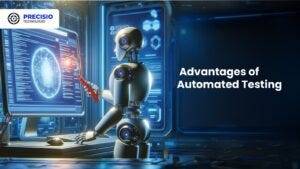
Speed: Executes repetitive tests much faster than humans.
Scalability: The system proves most effective for extensive projects that need constant system updates.
Accuracy: When performing recurring actions, automated systems minimize the chances of human mistakes.
Cost-Efficient in the Long Run: Once established and implemented, the system demands costly investments but ensures continuous development expenses decrease over time.
Better for CI/CD Pipelines: Such testing technology connects various development pipelines that support agile and DevOps methodologies.
5. Disadvantages of Manual Testing

Time-Consuming: The manual performance of repeated tests leads to delayed completion of projects.
Error-Prone: Large applications contain tiny bugs that human testers commonly fail to detect.
Not Ideal for Scalability: The process of increasing manual testing needs additional testers to avoid cost escalations.
6. Disadvantages of Automated Testing

Initial Costs: Organizations must provide high financial resources to procure testing tools together with developing programming constructs.
Limited to Pre-Defined Scenarios: These testing approaches work poorly for handling exploratory or ad hoc testing.
Requires Maintenance: Test scripts need frequent updates when application changes occur.
Not Suitable for UI/UX Testing: Struggles with subjective user experience evaluations.
7. When to Use Manual Testing
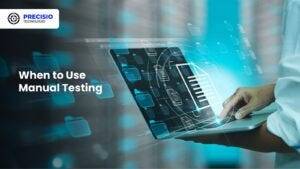
Small Projects: The testing method proves beneficial at a low cost for small applications and provides quick assessments.
Exploratory Testing: Testing this approach benefits projects whose scripts have not been defined yet or need evaluation for newly added features.
Visual and Usability Testing: Performing assessments on interface components together with design features.
8. When to Use Automated Testing
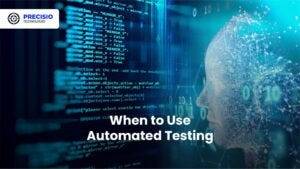
Large Projects: Handles scalability for projects with frequent updates.
Regression Testing: Program testing becomes more efficient through automation since automated assessments perform multiple tests following each update process.
Performance Testing: The system performs efficient capabilities to conduct load testing and stress testing.
Continuous Development Environments: Agile progression and DevOps implementations need automation as a core requirement.
READ MORE- https://www.precisio.tech/automated-testing-vs-manual-testing-which-one-is-right-for-your-project/
2 notes
·
View notes
Text
S1000d Software Working Process - Code and Pixels
A new buzzword in the technical publishing world. New word? Not exactly new, but surely it’s a new word in the Indian Defense Technical Publishing segment.
S1000D is an Interactive Electronic Technical Publishing(IETP). It’s also called #ietm too.
S1000d is not new but very few Indian companies, which support documentation of foreign Airline documentation are similar to #S1000d word. But almost 90 % of the people who do S1000D conversation do not know what s1000d is.
#s1000d#s1000d benefits of xml#s1000d data module code#s1000d ietm#s1000d infographics#s1000d software#s1000d standard for technical publications#s1000d working process#s1000d basic principle#what is s1000d#s1000d ietm ietp#benefits of s1000d#s1000d standard pdf#s1000d pdf#s1000d download#s1000d example#s1000d chapters#s1000d explained#why s1000d#Electronic Technical Manuals#Hyderabad IETM developers#IETM#IETM vendors#IETM Designers#IETM Designing#companies of Hyderabad#IETM Development#e-content#IETM Development In India#IETM Framework
2 notes
·
View notes
Text
IETM for Beginners A Quick Guide to IETM Code and Pixels
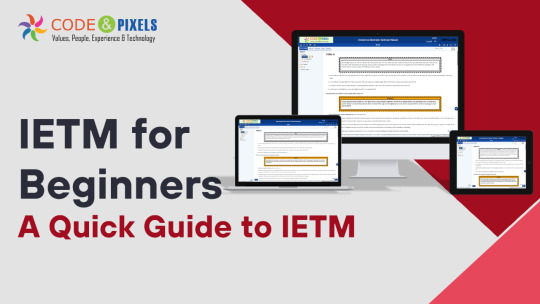
IETM: Interactive Electronic Technical Manual
Training Aids to Defence Client
If you are a supplier of defence then along with the system/equipment you also need to provide Training Aids
(CBT) — Computer-Based Training
Charts and Bloups
Video Film
Training Work Modules
Manuals Hard Copies
IETM
Evolution of Documentation in Defence
Before — Hardcopies and PDFs in DVDs (Upto 2015)
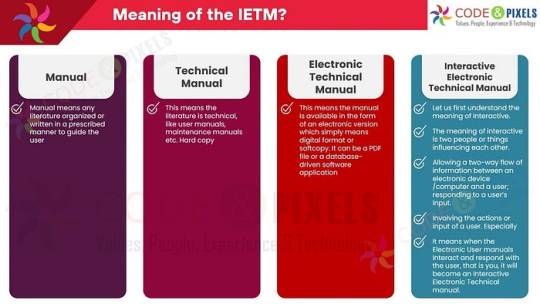
What is the meaning of the IETM?
Manual: Manual means any literature organized or written in a prescribed manner to guide the user.
TechnicalManual: This means the literature is technical, like user manuals, maintenance manuals etc. Hard copy
Electronic Technical Manual: This means the manual is available in the form of an electronic version which simply means digital format or softcopy. It can be a PDF file or a database-driven software application.
Interactive Electronic Technical Manual:
Let us first understand the meaning of Interactive. The meaning of interactive is two people or things influencing each other.
Allowing a two-way flow of information between an electronic device /computer and a user; responding to a user’s input.
Involving the actions or input of a user. Especially
It means when the Electronic User manuals Interact and respond with the user, that is you, it will become an Interactive Electronic Technical manual.
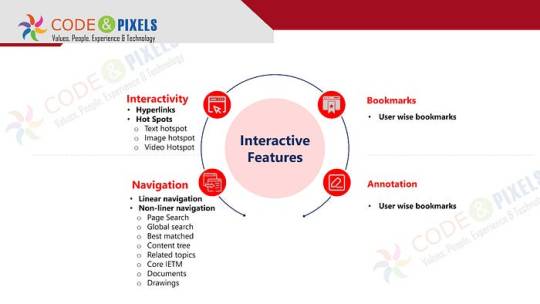
Interactive Features
Interactivity
Hyperlinks
Hot Spots
Text hotspot
Image hotspot
VideHotspot
Bookmarks
User wise bookmarks
Navigation
Linear navigation
Non-liner navigation
Page Search
Global search
Best matched
Content tree
Related topics
Core IETM
Documents
Drawings
Annotation
User wise bookmarks
The documents and pages are many hence, for easy and fast accessibility complete content is converted and stored as a database.
Whenever the user wants some information, IETM software produces the information in a fraction of a second.
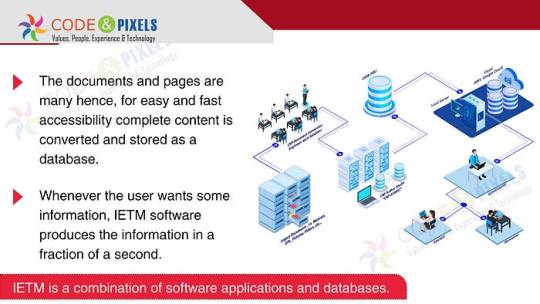
Use or Purpose of the IETM?
The purpose of the Manual is to give information related to the equipment to the end user for quick reference.
All the technicality is written in detail so that when an issue arises, the user can refer to the manual, as every time OEM or technical person or subject matter expert might not be available on the spot to resolve the issue.
If the manual has 10 pages users can refer easily.
But any system used by the defence will have multiple manuals and thousands of page counts and many times a user has to cross-refer between manuals, intra-manual and inter-manual to resolve the issue.
Referring to 10- 15 hard-copy or even soft-copy books simultaneously will be difficult and time-consuming.
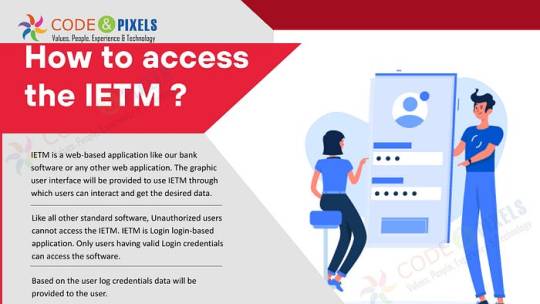
How to access the IETM ?
IETM is a web-based application like our bank software or any other web application. The graphic user interface will be provided to use IETM through which users can interact and get the desired data.
Like all other standard software, Unauthorized users cannot access the IETM. IETM is a Login - login-based application. Only users having valid Login credentials can access the software.
Based on the user log credentials data will be provided to the user.
IETM has 2 types of Users and one Administrator
Maintainer
Operator
If the operator logs in, the user gets all the content related to operator use, similarly if the maintainer logs in only maintenance-related content is visible for that user.
Ideally, all the content is available for both users, because the purpose of the IETM is to refer to the manual to fix the issue.
Administrators can create users who can see the user’s navigation and log-in history and interact with the users using user dashboards through Annotations.
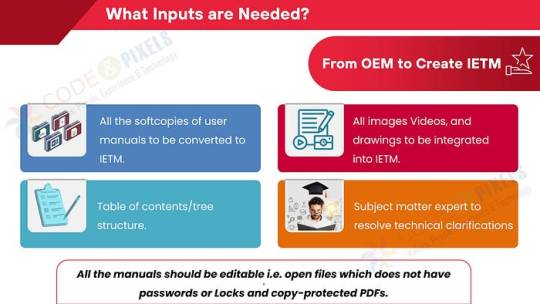
What Inputs are Needed? (From OEM to Create IETM)
All the softcopies of user manuals to be converted to IETM.
All images Videos, and drawings to be integrated into IETM.
Subject matter expert to resolve technical clarifications
Table of contents/tree structure.
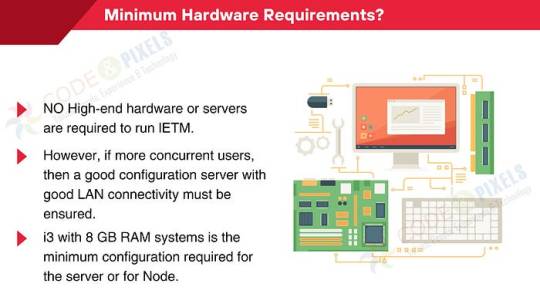
Minimum Hardware Requirements?
NO High-end hardware or servers are required to run IETM.
However, if more concurrent users, then a good configuration server with good LAN connectivity must be ensured.
i3 with 8 GB RAM systems is the minimum configuration required for the server or for Node.
Deliverables
BASED DB (Manuals are covered in the Database)
IETM VIEWER Software
User Manual and Installation Manual
Standards — compliance
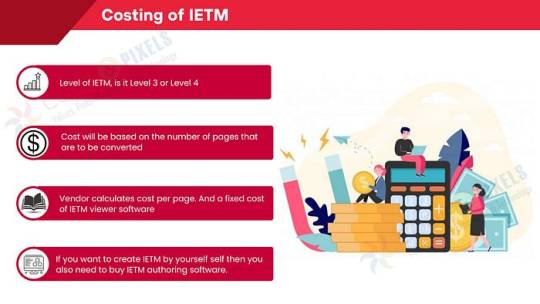
Costing of IETM: (Interactive Electronic Technical Manual)
Level of IETM, is it Level 3 or Level 4
Cost will be based on the number of pages that are to be converted
The vendor calculates the cost per page. And a fixed cost of IETM viewer software
If you want to create IETM by yourself self then you also need to buy IETM authoring software.
What are these Levels?
Level — 1 is any PDF file
Level — 2 is a PDF file with hyperlinks from the table of contents to the body etc.
Level — 3 is an HTML application. More hyperlinks, simple search, a content tree having log a screen with a hardcoded username and password and supplied in the format of EXE so that Windows can easily open
Level — 4 is Software plus Content/manuals converted as Database
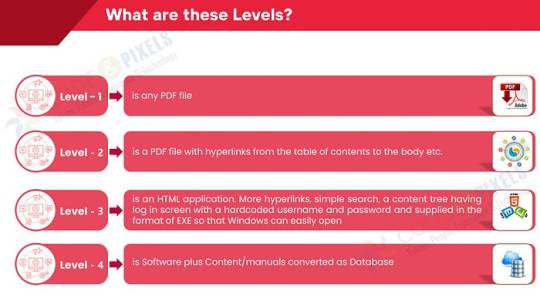
Regarding Level — 5, rest assured, till 2028 it will be Level — 4 only. As of now, there is nothing practically called Level — 5. Few are calling virtual reality and Augmented reality and Artificial intelligence Level — 5.
Pulling data from many user inputs and analyzing and giving results are done in Level — 5. IETM software cannot pull the data from various real-time points as No OEM will give the real-time information to third-party software directly. Yes, if the information is available offline, then that information can be imported into IETM and can be used as a reference.

#ietm#software#technology#ietm developement#ietm code and pixels ietm hyderabad#ietm software#elearning#code and pixels#ietm level iv#codeandpixels#ietm level 4 software requirements#technical documentation#ietm document#ietm documentation#interactive electronic technical manual#Ietm Service Providers#Ietm Software Designers of India#Software Development Company#Elearning Solutions Company#E Learning Content Development Company#Online Education#Digital Education#Digital Content#Software Development Solutions#Elearning#Ietm Developers#Econtent Development#Elearning Solutions Providers#Econtent Developers#Econtent
3 notes
·
View notes
Text
Now I know why my job is a software engineer and not a software developer
#I give tech support to software developer and fix the tools they use#IT'S AWFUL IN THE SENSE THAT THERE'S LITTLE TO NO DOCUMENTATION ONLINE SO I HIT THOSE DUSTY AF MANUALS
3 notes
·
View notes
Text
youtube
D2i Technology: Expert IT Solutions for Your Business
D2i Technology is a trusted and Expert IT solutions provider specializing in DevOps, web application development, accessibility testing and remediation, manual testing, infrastructure optimization, and cybersecurity solutions. With a team of certified developers and testers, we ensure efficient software deployment, secure and accessible applications, seamless functionality, and cost-effective IT operations. We help businesses reduce downtime, prevent ransomware attacks, and optimize infrastructure for improved performance and savings.
#Expert IT Solutions#Web Developement Service#Mobile Development Service#Manual Testing Service#Manual Software Testing Company In Usa#Youtube
1 note
·
View note
Text
What are the steps involved in automated functional testing?
Functional Testing Services

Automated functional testing helps ensure that every feature of a software application works exactly as expected. Unlike manual testing, which relies on testers to check each function step by step, automation uses tools and scripts to speed up the process and improve accuracy. Here's a simple breakdown of the main steps involved in automated functional testing.
1. Requirement Analysis:
The first step, or the starting stage, is to know and understand precisely what the application and product should do. Testers review business and functional requirements to identify which features must be tested. This step ensures that the tests cover all critical functions of the application.
2. Test Planning and Tool Selection:
Once the requirements and demands are matched and understood, the next step is to create a well planned testing strategy. While this process consists of selecting the right set of tools and resources for automation (like Selenium, TestComplete, or UFT), defining the major test objectives, identifying the common test data, and deciding which tests are meant to automate based on the features' complexity, frequency, stability.
3. Test Case Design:
Testers and professionals seek to write up the automated test scripts based on the application's functionality in this phase as a common practice. Each script simulates a user action that verifies that the particular feature works correctly and goes well as said. Well-designed scripts ensure that key business processes are tested thoroughly.
4. Environment Setup:
Moving ahead towards the further tests process, it's essential to craft the test setting premises. As it consists of configuring servers, databases networks, and required alignments for better approach and perfection. As the stable setting assures accurate test results will be settled out and procured as per the given concerns.
5. Test Execution & Completition:
While the automated scripts are executed all across the different devices, platforms, or browsers as needed and approached. Tools run the tests, capture results, and log failures or issues. This step is much faster than manual testing and allows repeated testing without extra effort.
6. Result Analysis and Reporting:
After the tests run, the results are reviewed. Any failed tests are analyzed to identify the root cause. Detailed and complete set reports are generated and shared within the knowledge of the development team for fixing the issues quickly and with less time consideration.
7. Maintenance:
As the application evolves, automated scripts need to be updated. Maintenance assures the functional testing suite stays relevant and appropriate and tends to delivers accurate results over time. Companies like Suma Soft, IBM, Cyntexa, and Cignex are experienced in offering reliable automated functional testing services. Their expertise helps businesses maintain software quality while speeding up delivery and reducing testing efforts.
#software testing#it services#technology#software#saas#saas development company#functional testing#manual testing
1 note
·
View note
Text
Documentation Standards Vs IETM Standards
EED-S-048, DME 452, and NCD 1470 are Navy standards for equipment documentation, not directly related to IETM development. Your technical team uses these standards to create manuals. Once approved, the content is formatted to JSS – 0251 standards and shared with IETM vendors like Code and Pixels for conversion to IETMs based on JSG 0852 standard.
#technical documentation#dme 452#ietm developement#ietm document#ietm documentation#ietm framework#documentation standards#ietm manual#ietm development in hyderabad#ietm software#ietm standard eed-s-048#ietm vendors#interactive electronic technical manual software#jsg 0852#jss 251#ncd 1470
0 notes
Text
PureCode AI review | The decision between Node.js and Next.js
The decision between Node.js and Next.js primarily hinges on the project requirements. For projects requiring rapid development, Node.js’s flexibility, due to the absence of strict conventions, can result in longer development times as utilities may need to be implemented manually.
#Node.js and Next.js#purecode ai company reviews#purecode software reviews#purecode#purecode ai reviews#purecode company#purecode reviews#longer development#implemented manually.
0 notes
Text
Software Development Mastery

Link ebook
1 note
·
View note
Text
Software Quality Dimensions
Any software development organization aims to achieve high software quality. Software quality is complex and has many aspects, contrary to popular belief that software quality is just the number of bugs. The ISO/IEC 25010 standard gives eight dimensions from which to evaluate software quality. Every aspect is essential either from the customer's perspective or from the development organization's.
The Eight Dimensions of Software Quality
The following dimensions are as per the ISO/IED 25010 software quality model:
1. Functional Suitability
Functional suitability is about how well the software operates for the end-users. High-quality software will have no missing functionality, a low defect rate, and quickly solve end-user problems.
How to evaluate:
Integration testing
Regression testing
Acceptance testing
UI automation
2. Performance
Performance refers to how well the software performs under various workloads. High-quality software will be scalable, have low response times, high throughput, and optimal hardware and software utilization.
How to evaluate:
Stress testing
Page load times
Soak testing
3. Usability
Usability refers to how easily end-users can use and benefit from the software. A highly usable software is easy to learn and use, is accessible to users with special needs, protects end-users from errors, and is pleasing to the eye.
How to evaluate:
User acceptance testing
Website engagement and conversion monitoring
Real user monitoring
Customer satisfaction survey
4. Reliability
Reliability refers to a software system's resistance and resilience to malfunctions. A reliable software works consistently over long periods, has high availability, is fault-tolerant, and recovers quickly from crashes.
How to evaluate:
Soak testing
Load testing
Regression testing
5. Compatibility
Compatibility refers to the software's ability to coexist and work with existing software and hardware. A highly compatible software will work seamlessly across various hardware, operating systems, and screen sizes.
How to evaluate:
Cross-browser testing
UI automation
6. Maintainability
Maintainability refers to how quickly you can modify your code to meet new requirements. High-quality code is modular, reusable, analyzable, adaptable, and easily testable. Complex code is less maintainable. However, poorly written and undocumented code is even worse.
How to evaluate:
Lines of Code (LOC)
Static code analysis
Cyclomatic complexity evaluation
Peer review
7. Portability
Portability refers to how easily you can move the software to another execution environment. High-quality portable code can adapt to evolving software and hardware platforms. It is easy to install and requires minimal external dependencies.
How to evaluate:
Setting realistic environments for testing.
Automating installation/uninstallation testing
Platform-specific UI and regression testing
8. Security
Security refers to the vulnerability of the software to malicious attacks and unintended end-user actions. Highly secure software is resistant to cyber-attacks. It also has a high degree of authenticity, confidentiality, non-repudiation, and accountability.
How to evaluate:
Vulnerability scanning
Malware scanning
Ethical hacking
0 notes
Text

The Importance of QA & Software Testing Services Explained
Ensuring the quality and reliability of your software is crucial in today’s competitive market. Comprehensive QA and software testing services play a vital role in identifying and fixing issues early, enhancing performance, security, and user experience. These services include a range of testing types such as manual testing, automated testing, performance testing, and security assessments. By implementing robust testing strategies, you can ensure your software operates seamlessly across all devices and platforms, providing a superior user experience that drives satisfaction and retention.
Manual Testing
Manual testing involves human testers who evaluate the functionality, usability, and overall user experience of your software. This type of testing is crucial for identifying bugs and issues that automated tests might miss. Our approach combines exploratory testing, where testers explore the application without predefined test cases, and acceptance testing, which verifies if the software meets the business requirements.
Exploratory Testing: Testers use their creativity and intuition to uncover unexpected issues.
Acceptance Testing: Ensures that the software meets the specified requirements and is ready for release.
Regression Testing
Regression testing ensures that new updates or changes do not negatively impact the existing functionality of your software. By re-running previously conducted tests, we verify that new code changes do not introduce new bugs or break existing features.
Comprehensive Coverage: We re-test all major functionalities to ensure stability.
Automated Regression Tests: We use automated tools to quickly and efficiently execute regression test cases.
Web and Mobile QA
Our QA services for web and mobile applications ensure that your software delivers a seamless experience across all devices and platforms. We test your applications under various conditions and configurations to identify and resolve any issues.
Cross-Device Testing: Ensures compatibility across different devices (smartphones, tablets, desktops).
Cross-Platform Testing: Verifies that your application works smoothly on different operating systems (iOS, Android, Windows, macOS).
Performance Testing
Performance testing is critical to ensure that your software can handle high traffic and perform well under stress. We use advanced tools and techniques to simulate peak loads and identify performance bottlenecks.
Load Testing: Measures the application’s performance under expected user load.
Stress Testing: Evaluates how the application performs under extreme conditions.
Scalability Testing: Ensures the application can scale up to accommodate increasing user loads.
Automation Testing
Automation testing uses specialized software tools to execute pre-scripted tests on your application. This approach reduces the need for manual testing, improves test accuracy, and increases test coverage.
Test Automation Frameworks: We build and maintain robust test automation frameworks tailored to your needs.
Continuous Integration (CI): Integrates automated tests into your CI pipeline to ensure regular and consistent testing.
API Testing
API testing ensures that your application’s APIs function correctly and deliver the expected performance. We validate data flows, endpoint reliability, and performance to guarantee seamless integrations with other systems.
Functionality Testing: Verifies that the API endpoints perform their intended functions.
Performance Testing: Measures the responsiveness and stability of the APIs under various conditions.
Security Testing: Ensures that APIs are secure and protect against vulnerabilities.
API Security Testing
API security testing identifies and fixes vulnerabilities in your APIs to safeguard your software from potential threats. We conduct thorough security assessments to ensure that your APIs are resilient against attacks.
Vulnerability Assessment: Identifies security flaws and potential weaknesses.
Penetration Testing: Simulates real-world attacks to test the API’s security measures.
Compliance Testing: Ensures that your APIs comply with industry security standards and regulations.
Ready to ensure the highest quality for your software? Contact us today to learn how our comprehensive QA and software testing services can help you deliver flawless, reliable applications.
Get in touch with us now and take the first step towards superior software quality!
#testing#automation testing#software testing#technology#user testing#manual testing#product testing#software development#testing services
0 notes
Text
Computer-based Training (CBT) Uses, Meaning and Advantages
If you're a student, healthcare provider, technology expert, or a brave soldier, CBT can serve as your hidden tool for learning and improving your skills. It's like having an incredible learning toolkit that makes even the most challenging subjects simple and enjoyable to understand!
#Electronic Technical Manuals#Hyderabad IETM developers#IETM#IETM Designers#IETM Designing#companies of Hyderabad#IETM Development#IETM Development In India#IETM Framework#IETM Level 4#IETM Manual IETM Development in Hyderabad#IETM service providers of Hyderabad#IETM Software#IETM software designers of Hyderabad#IETM software designers of INDIA#IETM Technical Manual#IETM vendors#Interactive Electronic Technical Manual#Interactive Electronic Technical Manual Software#What is IETM#Interactive Electronic Technical Publishing#code and pixels#ietm#ietm presentation#ietm s1000d ietp#ietm Level-iv#software#technology#s1000d#interactive electronic technical manual
1 note
·
View note
Text
This article explores some crucial software testing trends that are set to define the industry in 2024 and beyond. From AI-driven testing integration to the emergence of green computing, these insights will define how testing practices will evolve in the coming years.
0 notes
Text
Testing
Delivering exceptional software requires a keen eye for quality. At Alt Digital Technologies, we don't just develop, we engineer trust through our comprehensive testing solutions. We focus on delivering top-notch quality assurance, the cornerstone of any successful software product. Our proficiency in automated testing, ensures your software’s seamless performance, saving valuable time and resources.
We also value the importance of manual testing in software testing. Our adept testers are thorough in their approach, ensuring no potential issue goes unnoticed. Equipped with a range of automated software testing tools, we offer a balanced testing solution that combines the speed of automation with the meticulousness of manual testing. Choose Alt Digital Technologies for a flawless software experience.

#software testing#technology#manual testing#testing#software#technologies#commerce tools#digital strategy consultant#software devops service#digital customer experience services#it consulting services#it service provider#devops service#softwaredevelopment#software company#IT Solutions#web development#digital marketing#digital commerce#Digital Transformation#digital experience#ALTDigital#Alt Digital#salesforce#salesforce cloud#Salesforce Development#Salesforce development services#Salesforce developers#salesforce partner#salesforce services
0 notes
Text
Tailor-Made digital services on Software Development and Digital Marketing | WSE Infratech
We are a digital consultancy, specialised in web and product development to marketing including seo, social media & product branding.
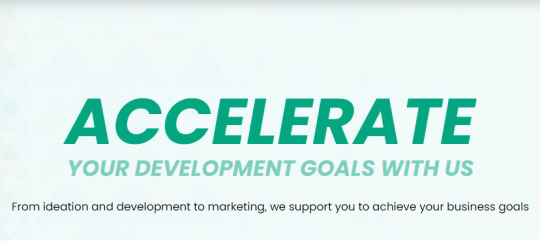
#Software Development Service#Product Development Service#Manual and Automation QA Service#Marketing Strategy Service#Digital Marketing Service#Content Marketing Service
0 notes
Text
Interactive Electronic Technical Manual: IETM Images
The word "IETM" stands for "Interactive Electronic Technical Manual," and it refers to an interactive manual and electronic/digital format. If a PDF file is electronic or digital, will that be referred to as an IETM? is an Interactive Electronic Technical Manual range from Level 3 , 4 and 5.
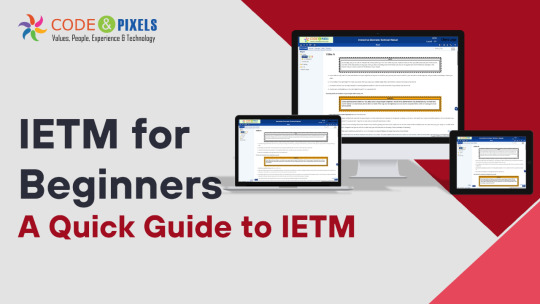
IETM for beginners A Quick Guide to IETM -Code and Pixels
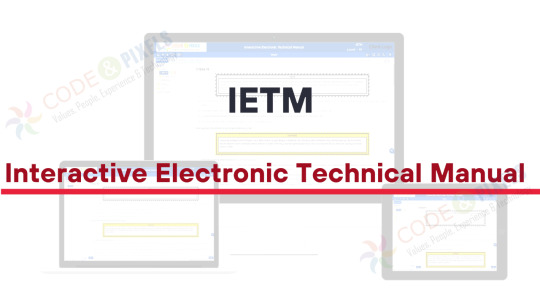
IETM for beginners - Interactive Electronic Technical Manual

IETM for beginners - Training Aids to Defence Client

What is the Meaning of IETM Software -Code and Pixels

IETM for beginners - Interactivity Features

IETM for beginners - Use or Purpose of the IETM
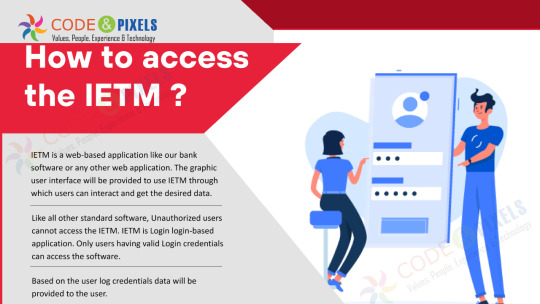
IETM for beginners - How to access the IETM
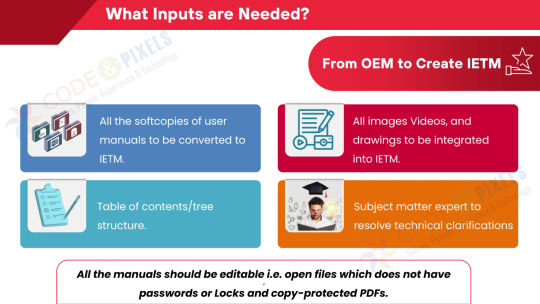
IETM for beginners - OEM to Create IETM

IETM for beginners - Minimum Hardware Requirements for IETM

IETM for beginners - What is IETM and What is Not IETM
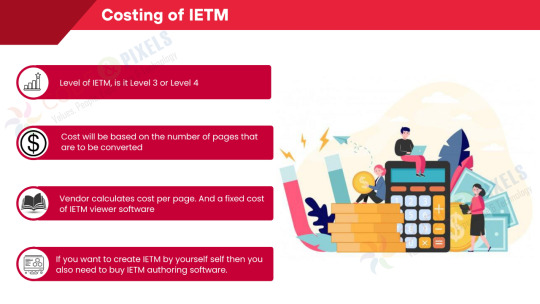
IETM for beginners - Costing of IETM Interactive Electronic Technical Manual

What are IETM Interactive Electronic Technical Manual Levels
#ietm for beginners#interactive electronic technical manual#ietms#technical documentation#ietm service providers#ietm developer#ietm designer#ietm software developers#ietm software development#ietm software#ietm level 4#code and pixels ietm software solutions#what is ietm software
1 note
·
View note